Challenges and Future of the Oil and Gas Industry: A Report
VerifiedAdded on 2022/08/11
|20
|4415
|94
Report
AI Summary
This report provides a comprehensive analysis of the oil and gas industry, focusing on its uncertain future. It begins with an introduction that sets the context, addressing the core question and outlining the approach to answering it. The main body of the report delves into the key challenges facing the industry, including price volatility in the global market, industry trends, environmental concerns, and the issue of limited reserves. The analysis is supported by a review of literature and external sources. The report examines the fluctuation in crude oil prices, the impact of economic and geopolitical events, and the evolving trends within the industry. It also addresses environmental concerns, the impact of limited reserves, and future planning. The conclusion synthesizes the main points, answers the central question, and summarizes the findings, offering insights into the industry's complex landscape.
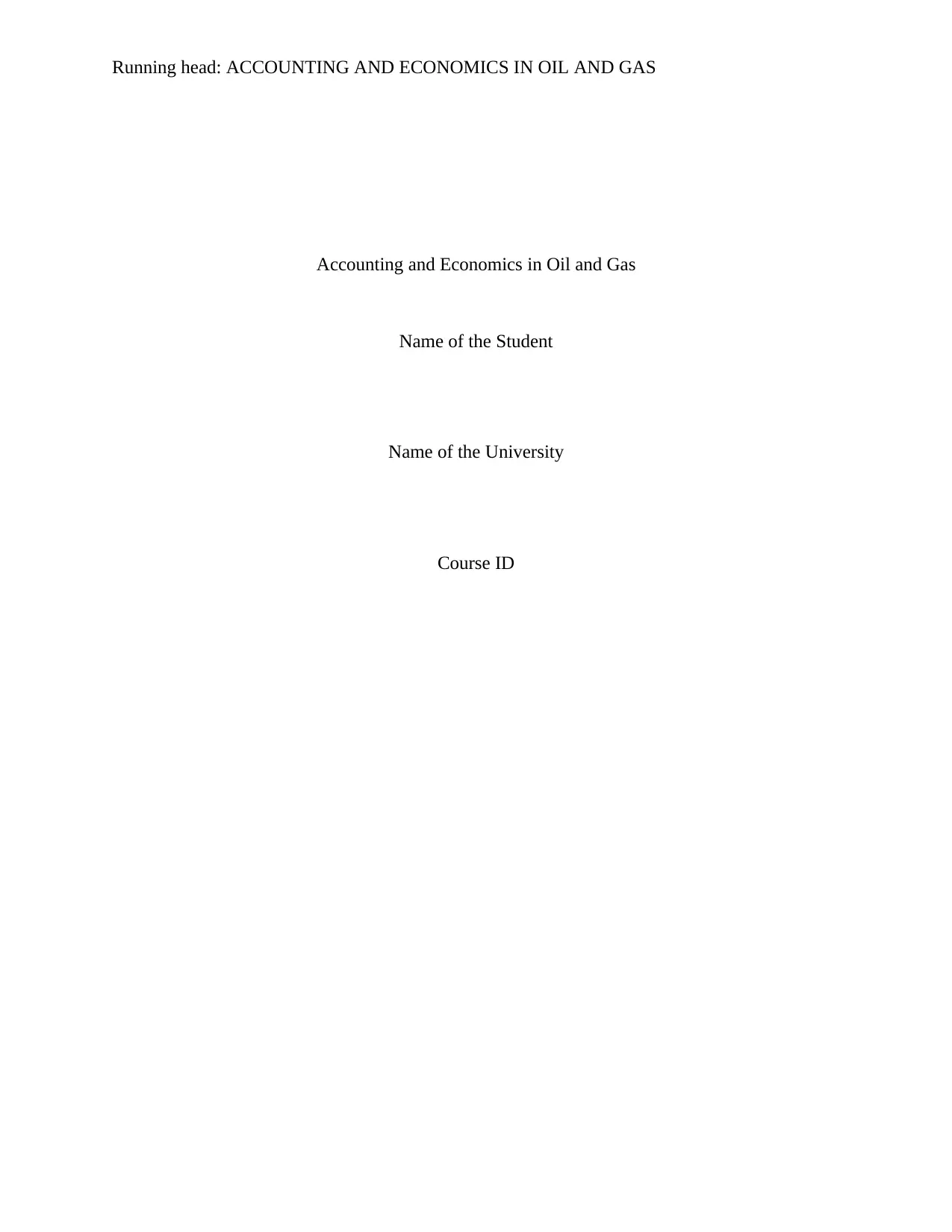
Running head: ACCOUNTING AND ECONOMICS IN OIL AND GAS
Accounting and Economics in Oil and Gas
Name of the Student
Name of the University
Course ID
Accounting and Economics in Oil and Gas
Name of the Student
Name of the University
Course ID
Paraphrase This Document
Need a fresh take? Get an instant paraphrase of this document with our AI Paraphraser

1ACCOUNTING AND ECONOMICS IN OIL AND GAS
Table of Contents
Introduction......................................................................................................................................2
Uncertainties related to oil and gas industry....................................................................................3
Volatility in global oil price.........................................................................................................3
Oil and gas industry trends..........................................................................................................6
Environmental concern..............................................................................................................11
Limited Reserves.......................................................................................................................12
Future planning..........................................................................................................................13
Conclusion.....................................................................................................................................14
References......................................................................................................................................16
Table of Contents
Introduction......................................................................................................................................2
Uncertainties related to oil and gas industry....................................................................................3
Volatility in global oil price.........................................................................................................3
Oil and gas industry trends..........................................................................................................6
Environmental concern..............................................................................................................11
Limited Reserves.......................................................................................................................12
Future planning..........................................................................................................................13
Conclusion.....................................................................................................................................14
References......................................................................................................................................16

2ACCOUNTING AND ECONOMICS IN OIL AND GAS
Introduction
The oil and gas industry is one of the most vital industries in the world economy. Spread
of the industry is actually global with industry’s operation occurring all over the globe from
Australia to Alaska, from China to Peru and in every habitat from Arctic region to desert, from
mangrove to offshore and from temperate woodland to tropical rainforest. Dominance of the
industry continues in parallel with economic advances that the world economy is experiencing
since 20th century. The single industry dominates majority of energy mix globally. Despite
significant importance of oil and gas industry the industry is facing several challenges. Globally,
oil prices are highly volatile. The volatility in oil price is attributed from different factors related
to demand, supply and different geo-political events. The ongoing lower price environment
persisting since last few years has affected almost all the segments involved in the value chain of
oil and gas. The lower price means a lower revenue and profit and therefore, an uncertain future
growth. Imbalances between supply and demand is a series cause of concern for the industry.
Because of a downturn in oil prices many of the major investment projects of the industry have
been deferred interrupting supply (Dickson, Slaughter & Mittal, 2019). With a decline in
potential supply, global demand of hydrocarbon is growing indicating a potential challenge for
oil companies to meet the demand. The stringent environmental regulation to minimize the
environmental damage associated with extraction and related intermediary process requires oil
companies to adapt new technology to comply with the regulation. This has increased significant
cost burden for the industry. Another concern for oil companies is the limited reserve of
conventional sources of oil and gas. The paper sheds lights with some of the current issues
concerning the industry by discussing price movement, industry trends, environment concerns
and problems of limited reserve.
Introduction
The oil and gas industry is one of the most vital industries in the world economy. Spread
of the industry is actually global with industry’s operation occurring all over the globe from
Australia to Alaska, from China to Peru and in every habitat from Arctic region to desert, from
mangrove to offshore and from temperate woodland to tropical rainforest. Dominance of the
industry continues in parallel with economic advances that the world economy is experiencing
since 20th century. The single industry dominates majority of energy mix globally. Despite
significant importance of oil and gas industry the industry is facing several challenges. Globally,
oil prices are highly volatile. The volatility in oil price is attributed from different factors related
to demand, supply and different geo-political events. The ongoing lower price environment
persisting since last few years has affected almost all the segments involved in the value chain of
oil and gas. The lower price means a lower revenue and profit and therefore, an uncertain future
growth. Imbalances between supply and demand is a series cause of concern for the industry.
Because of a downturn in oil prices many of the major investment projects of the industry have
been deferred interrupting supply (Dickson, Slaughter & Mittal, 2019). With a decline in
potential supply, global demand of hydrocarbon is growing indicating a potential challenge for
oil companies to meet the demand. The stringent environmental regulation to minimize the
environmental damage associated with extraction and related intermediary process requires oil
companies to adapt new technology to comply with the regulation. This has increased significant
cost burden for the industry. Another concern for oil companies is the limited reserve of
conventional sources of oil and gas. The paper sheds lights with some of the current issues
concerning the industry by discussing price movement, industry trends, environment concerns
and problems of limited reserve.
⊘ This is a preview!⊘
Do you want full access?
Subscribe today to unlock all pages.

Trusted by 1+ million students worldwide
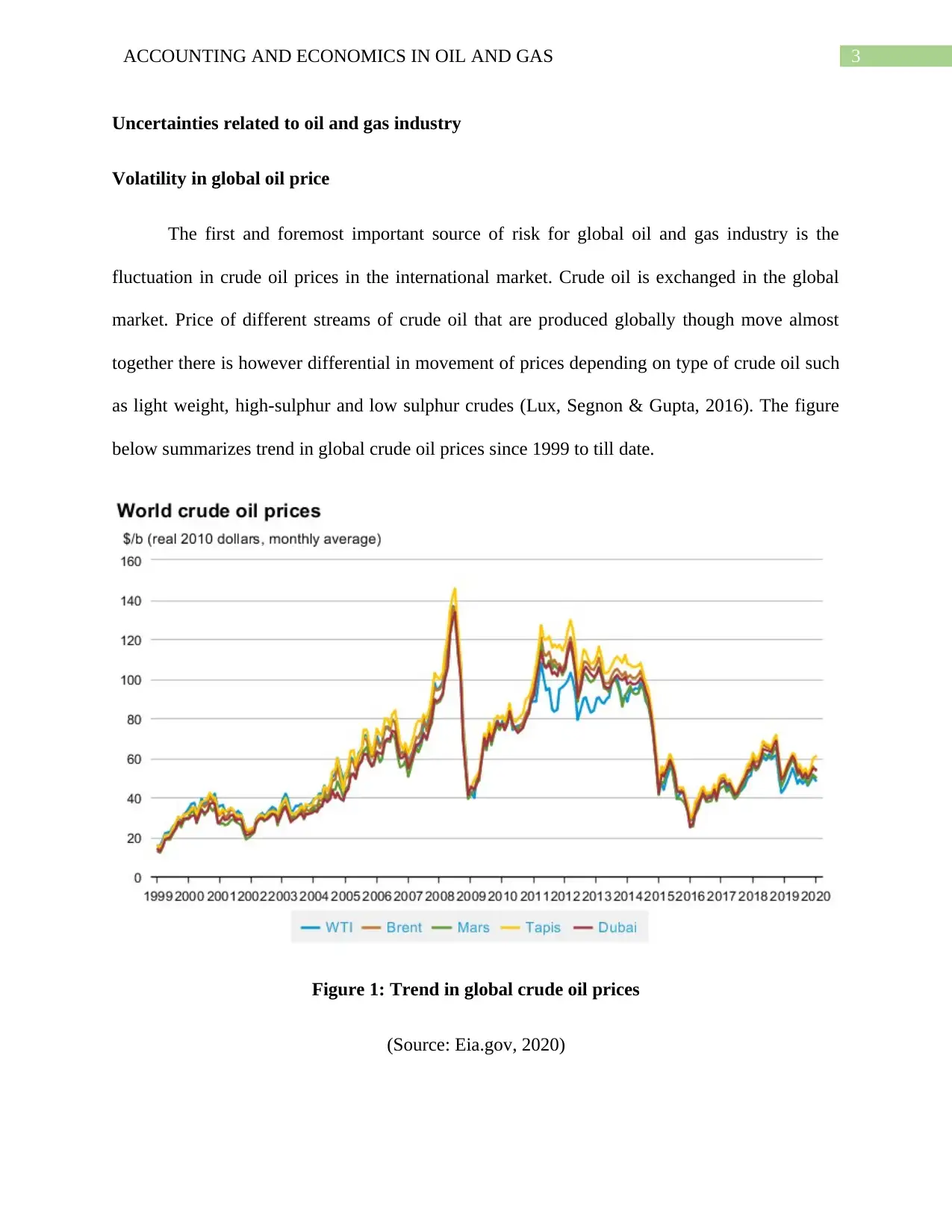
3ACCOUNTING AND ECONOMICS IN OIL AND GAS
Uncertainties related to oil and gas industry
Volatility in global oil price
The first and foremost important source of risk for global oil and gas industry is the
fluctuation in crude oil prices in the international market. Crude oil is exchanged in the global
market. Price of different streams of crude oil that are produced globally though move almost
together there is however differential in movement of prices depending on type of crude oil such
as light weight, high-sulphur and low sulphur crudes (Lux, Segnon & Gupta, 2016). The figure
below summarizes trend in global crude oil prices since 1999 to till date.
Figure 1: Trend in global crude oil prices
(Source: Eia.gov, 2020)
Uncertainties related to oil and gas industry
Volatility in global oil price
The first and foremost important source of risk for global oil and gas industry is the
fluctuation in crude oil prices in the international market. Crude oil is exchanged in the global
market. Price of different streams of crude oil that are produced globally though move almost
together there is however differential in movement of prices depending on type of crude oil such
as light weight, high-sulphur and low sulphur crudes (Lux, Segnon & Gupta, 2016). The figure
below summarizes trend in global crude oil prices since 1999 to till date.
Figure 1: Trend in global crude oil prices
(Source: Eia.gov, 2020)
Paraphrase This Document
Need a fresh take? Get an instant paraphrase of this document with our AI Paraphraser
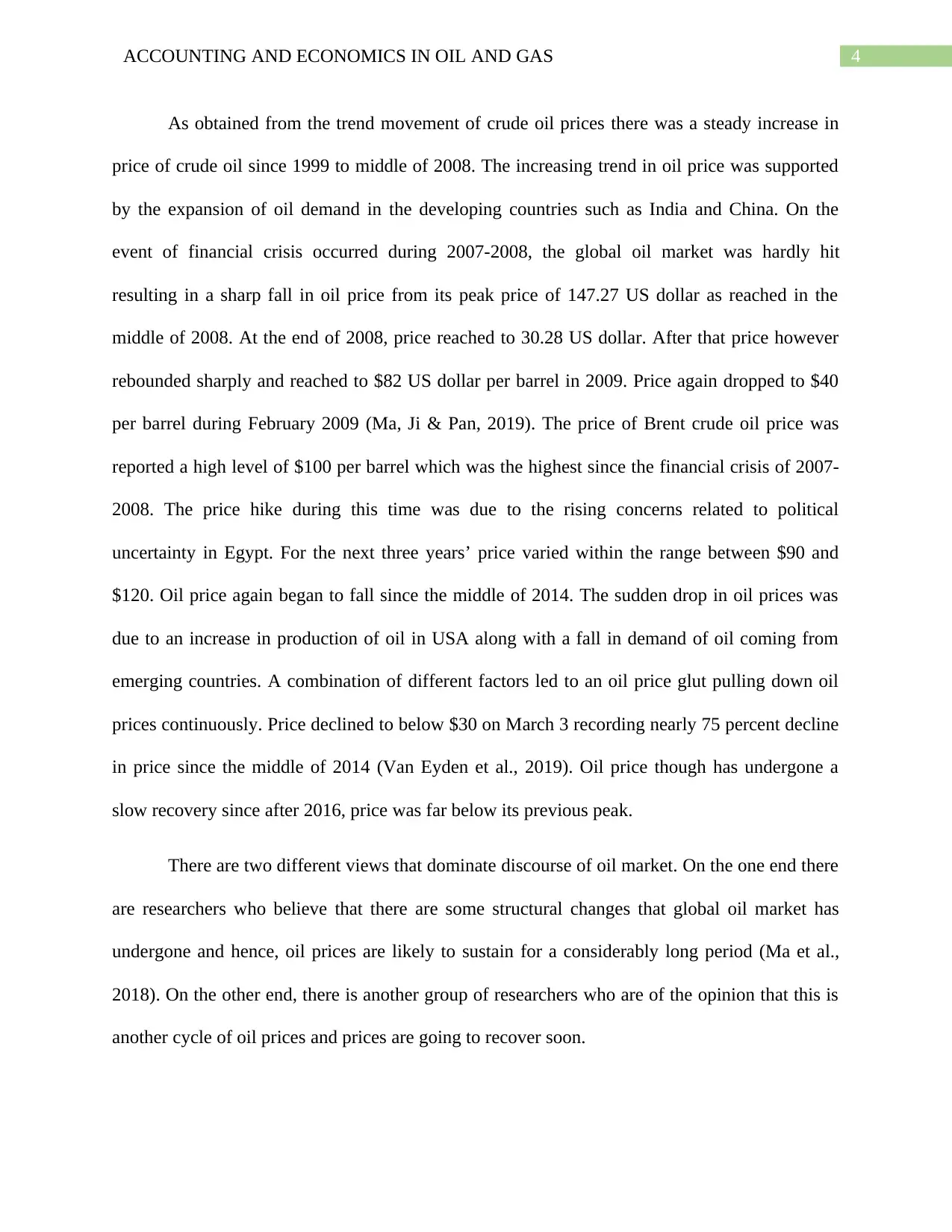
4ACCOUNTING AND ECONOMICS IN OIL AND GAS
As obtained from the trend movement of crude oil prices there was a steady increase in
price of crude oil since 1999 to middle of 2008. The increasing trend in oil price was supported
by the expansion of oil demand in the developing countries such as India and China. On the
event of financial crisis occurred during 2007-2008, the global oil market was hardly hit
resulting in a sharp fall in oil price from its peak price of 147.27 US dollar as reached in the
middle of 2008. At the end of 2008, price reached to 30.28 US dollar. After that price however
rebounded sharply and reached to $82 US dollar per barrel in 2009. Price again dropped to $40
per barrel during February 2009 (Ma, Ji & Pan, 2019). The price of Brent crude oil price was
reported a high level of $100 per barrel which was the highest since the financial crisis of 2007-
2008. The price hike during this time was due to the rising concerns related to political
uncertainty in Egypt. For the next three years’ price varied within the range between $90 and
$120. Oil price again began to fall since the middle of 2014. The sudden drop in oil prices was
due to an increase in production of oil in USA along with a fall in demand of oil coming from
emerging countries. A combination of different factors led to an oil price glut pulling down oil
prices continuously. Price declined to below $30 on March 3 recording nearly 75 percent decline
in price since the middle of 2014 (Van Eyden et al., 2019). Oil price though has undergone a
slow recovery since after 2016, price was far below its previous peak.
There are two different views that dominate discourse of oil market. On the one end there
are researchers who believe that there are some structural changes that global oil market has
undergone and hence, oil prices are likely to sustain for a considerably long period (Ma et al.,
2018). On the other end, there is another group of researchers who are of the opinion that this is
another cycle of oil prices and prices are going to recover soon.
As obtained from the trend movement of crude oil prices there was a steady increase in
price of crude oil since 1999 to middle of 2008. The increasing trend in oil price was supported
by the expansion of oil demand in the developing countries such as India and China. On the
event of financial crisis occurred during 2007-2008, the global oil market was hardly hit
resulting in a sharp fall in oil price from its peak price of 147.27 US dollar as reached in the
middle of 2008. At the end of 2008, price reached to 30.28 US dollar. After that price however
rebounded sharply and reached to $82 US dollar per barrel in 2009. Price again dropped to $40
per barrel during February 2009 (Ma, Ji & Pan, 2019). The price of Brent crude oil price was
reported a high level of $100 per barrel which was the highest since the financial crisis of 2007-
2008. The price hike during this time was due to the rising concerns related to political
uncertainty in Egypt. For the next three years’ price varied within the range between $90 and
$120. Oil price again began to fall since the middle of 2014. The sudden drop in oil prices was
due to an increase in production of oil in USA along with a fall in demand of oil coming from
emerging countries. A combination of different factors led to an oil price glut pulling down oil
prices continuously. Price declined to below $30 on March 3 recording nearly 75 percent decline
in price since the middle of 2014 (Van Eyden et al., 2019). Oil price though has undergone a
slow recovery since after 2016, price was far below its previous peak.
There are two different views that dominate discourse of oil market. On the one end there
are researchers who believe that there are some structural changes that global oil market has
undergone and hence, oil prices are likely to sustain for a considerably long period (Ma et al.,
2018). On the other end, there is another group of researchers who are of the opinion that this is
another cycle of oil prices and prices are going to recover soon.
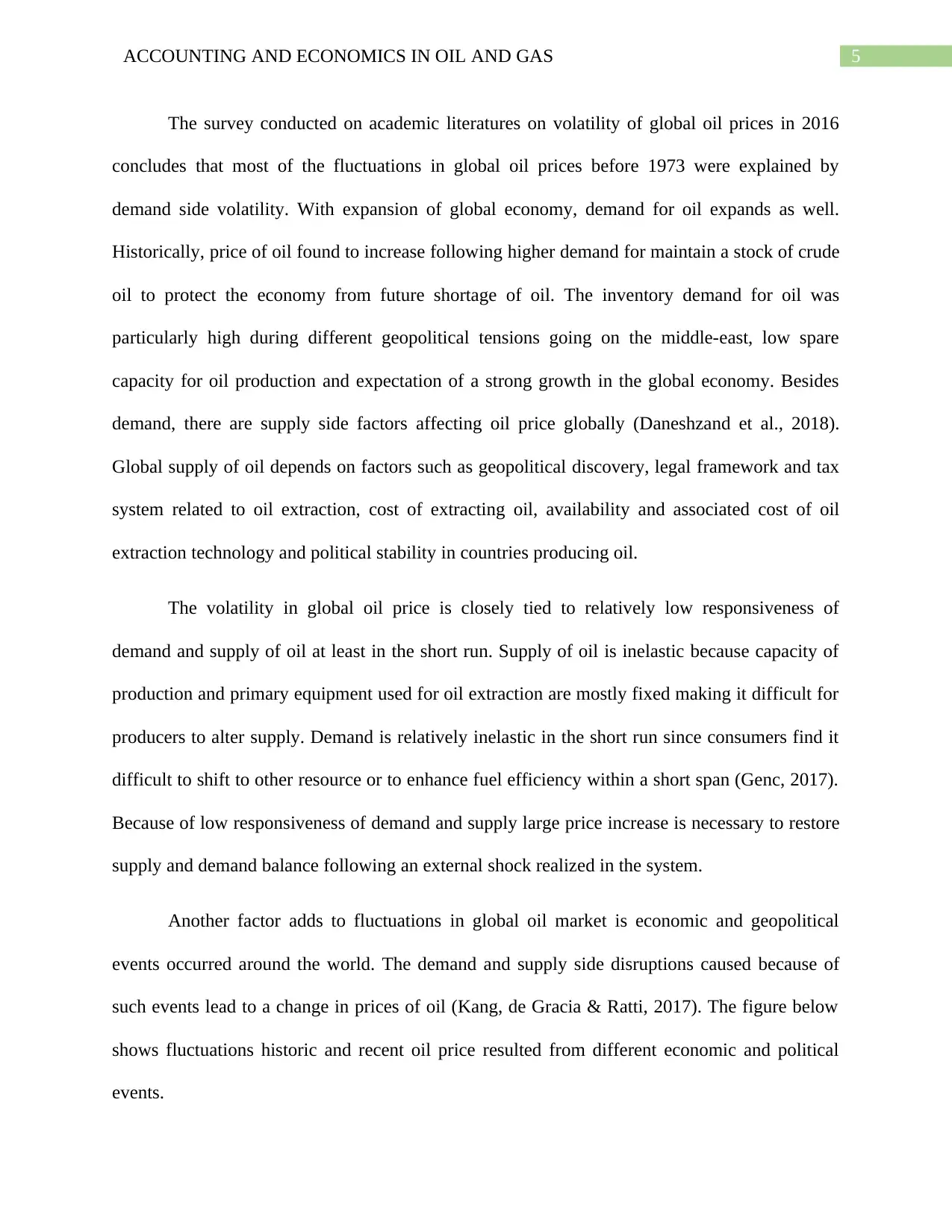
5ACCOUNTING AND ECONOMICS IN OIL AND GAS
The survey conducted on academic literatures on volatility of global oil prices in 2016
concludes that most of the fluctuations in global oil prices before 1973 were explained by
demand side volatility. With expansion of global economy, demand for oil expands as well.
Historically, price of oil found to increase following higher demand for maintain a stock of crude
oil to protect the economy from future shortage of oil. The inventory demand for oil was
particularly high during different geopolitical tensions going on the middle-east, low spare
capacity for oil production and expectation of a strong growth in the global economy. Besides
demand, there are supply side factors affecting oil price globally (Daneshzand et al., 2018).
Global supply of oil depends on factors such as geopolitical discovery, legal framework and tax
system related to oil extraction, cost of extracting oil, availability and associated cost of oil
extraction technology and political stability in countries producing oil.
The volatility in global oil price is closely tied to relatively low responsiveness of
demand and supply of oil at least in the short run. Supply of oil is inelastic because capacity of
production and primary equipment used for oil extraction are mostly fixed making it difficult for
producers to alter supply. Demand is relatively inelastic in the short run since consumers find it
difficult to shift to other resource or to enhance fuel efficiency within a short span (Genc, 2017).
Because of low responsiveness of demand and supply large price increase is necessary to restore
supply and demand balance following an external shock realized in the system.
Another factor adds to fluctuations in global oil market is economic and geopolitical
events occurred around the world. The demand and supply side disruptions caused because of
such events lead to a change in prices of oil (Kang, de Gracia & Ratti, 2017). The figure below
shows fluctuations historic and recent oil price resulted from different economic and political
events.
The survey conducted on academic literatures on volatility of global oil prices in 2016
concludes that most of the fluctuations in global oil prices before 1973 were explained by
demand side volatility. With expansion of global economy, demand for oil expands as well.
Historically, price of oil found to increase following higher demand for maintain a stock of crude
oil to protect the economy from future shortage of oil. The inventory demand for oil was
particularly high during different geopolitical tensions going on the middle-east, low spare
capacity for oil production and expectation of a strong growth in the global economy. Besides
demand, there are supply side factors affecting oil price globally (Daneshzand et al., 2018).
Global supply of oil depends on factors such as geopolitical discovery, legal framework and tax
system related to oil extraction, cost of extracting oil, availability and associated cost of oil
extraction technology and political stability in countries producing oil.
The volatility in global oil price is closely tied to relatively low responsiveness of
demand and supply of oil at least in the short run. Supply of oil is inelastic because capacity of
production and primary equipment used for oil extraction are mostly fixed making it difficult for
producers to alter supply. Demand is relatively inelastic in the short run since consumers find it
difficult to shift to other resource or to enhance fuel efficiency within a short span (Genc, 2017).
Because of low responsiveness of demand and supply large price increase is necessary to restore
supply and demand balance following an external shock realized in the system.
Another factor adds to fluctuations in global oil market is economic and geopolitical
events occurred around the world. The demand and supply side disruptions caused because of
such events lead to a change in prices of oil (Kang, de Gracia & Ratti, 2017). The figure below
shows fluctuations historic and recent oil price resulted from different economic and political
events.
⊘ This is a preview!⊘
Do you want full access?
Subscribe today to unlock all pages.

Trusted by 1+ million students worldwide
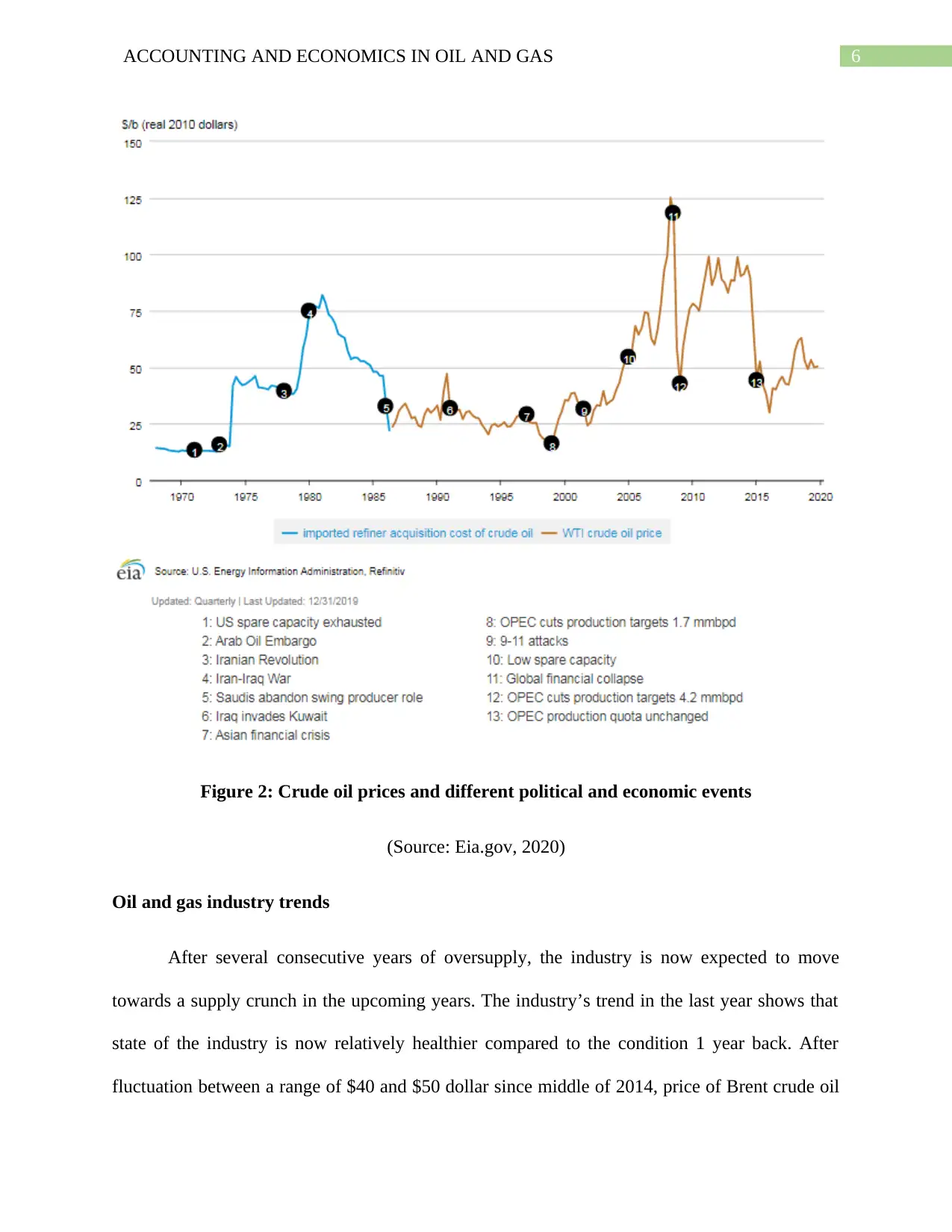
6ACCOUNTING AND ECONOMICS IN OIL AND GAS
Figure 2: Crude oil prices and different political and economic events
(Source: Eia.gov, 2020)
Oil and gas industry trends
After several consecutive years of oversupply, the industry is now expected to move
towards a supply crunch in the upcoming years. The industry’s trend in the last year shows that
state of the industry is now relatively healthier compared to the condition 1 year back. After
fluctuation between a range of $40 and $50 dollar since middle of 2014, price of Brent crude oil
Figure 2: Crude oil prices and different political and economic events
(Source: Eia.gov, 2020)
Oil and gas industry trends
After several consecutive years of oversupply, the industry is now expected to move
towards a supply crunch in the upcoming years. The industry’s trend in the last year shows that
state of the industry is now relatively healthier compared to the condition 1 year back. After
fluctuation between a range of $40 and $50 dollar since middle of 2014, price of Brent crude oil
Paraphrase This Document
Need a fresh take? Get an instant paraphrase of this document with our AI Paraphraser
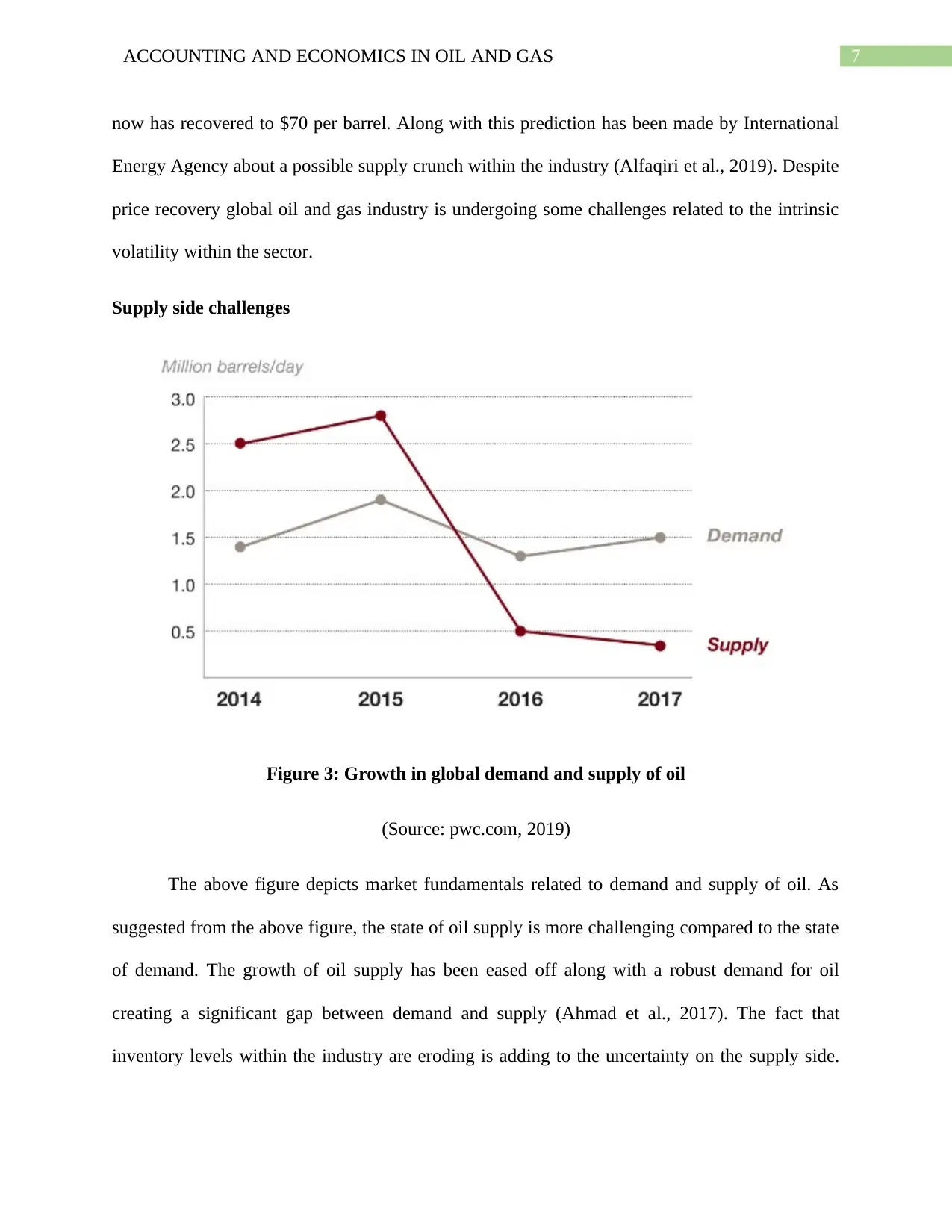
7ACCOUNTING AND ECONOMICS IN OIL AND GAS
now has recovered to $70 per barrel. Along with this prediction has been made by International
Energy Agency about a possible supply crunch within the industry (Alfaqiri et al., 2019). Despite
price recovery global oil and gas industry is undergoing some challenges related to the intrinsic
volatility within the sector.
Supply side challenges
Figure 3: Growth in global demand and supply of oil
(Source: pwc.com, 2019)
The above figure depicts market fundamentals related to demand and supply of oil. As
suggested from the above figure, the state of oil supply is more challenging compared to the state
of demand. The growth of oil supply has been eased off along with a robust demand for oil
creating a significant gap between demand and supply (Ahmad et al., 2017). The fact that
inventory levels within the industry are eroding is adding to the uncertainty on the supply side.
now has recovered to $70 per barrel. Along with this prediction has been made by International
Energy Agency about a possible supply crunch within the industry (Alfaqiri et al., 2019). Despite
price recovery global oil and gas industry is undergoing some challenges related to the intrinsic
volatility within the sector.
Supply side challenges
Figure 3: Growth in global demand and supply of oil
(Source: pwc.com, 2019)
The above figure depicts market fundamentals related to demand and supply of oil. As
suggested from the above figure, the state of oil supply is more challenging compared to the state
of demand. The growth of oil supply has been eased off along with a robust demand for oil
creating a significant gap between demand and supply (Ahmad et al., 2017). The fact that
inventory levels within the industry are eroding is adding to the uncertainty on the supply side.

8ACCOUNTING AND ECONOMICS IN OIL AND GAS
The rebalancing in the oil market is further rebalancing given the decision of OPEC along with
non-members of OPEC to lower the supply by 1.8 million barrels per day in 2018.
Figure 4: Investment expansion in oil and gas industry
(Source: pwc.com, 2019)
Globally, the upstream capital spending which was dropped by 45 percent from 2014 to
2016 has now recovered and is projected to increase by 6 percent annual basis over the medium
term. Activities related to oil and gas rig are on the rise, driven mostly by North American
market and approval of major projects. Several companies are taking steps to go ahead to raise
capital spending for exploration (Waterworth & Bradshaw, 2018). BP for example has gone
ahead to the second phase of Mad Dog representing floating platform for production. Shell has
taken the final decision regarding investment to develop Penguins field. With effective strategic
movement by different companies globally exploration has increased significantly since the
financial crisis in 2008.
The rebalancing in the oil market is further rebalancing given the decision of OPEC along with
non-members of OPEC to lower the supply by 1.8 million barrels per day in 2018.
Figure 4: Investment expansion in oil and gas industry
(Source: pwc.com, 2019)
Globally, the upstream capital spending which was dropped by 45 percent from 2014 to
2016 has now recovered and is projected to increase by 6 percent annual basis over the medium
term. Activities related to oil and gas rig are on the rise, driven mostly by North American
market and approval of major projects. Several companies are taking steps to go ahead to raise
capital spending for exploration (Waterworth & Bradshaw, 2018). BP for example has gone
ahead to the second phase of Mad Dog representing floating platform for production. Shell has
taken the final decision regarding investment to develop Penguins field. With effective strategic
movement by different companies globally exploration has increased significantly since the
financial crisis in 2008.
⊘ This is a preview!⊘
Do you want full access?
Subscribe today to unlock all pages.

Trusted by 1+ million students worldwide

9ACCOUNTING AND ECONOMICS IN OIL AND GAS
Figure 5: Long term decline in discoveries in oil and gas industries
(Source: pwc.com, 2019)
Despite projected increase in capital expenditure by companies to develop production
capacity the sector is undergoing different challenges related to supply. The first challenge is the
decline in new discoveries (Court & Fizaine, 2017). At the end of 2017, volume of new
discoveries in oil and gas industry reached to the lowest level since 1950s. In 2017, volume of
discoveries of liquid crude was only 3.5 billion meeting only 10 percent of aggregate demand.
The reason behind decline in discoveries include difficulties in finding large discoveries and
most of the possible areas have already been discovered. Another challenge in this area is the fall
in spending for exploration because of the collapse of oil prices between 2014 and 2016 (Zou et
al., 2016). Spending contracted by nearly more than 60 percent from 153 billion USD in 2014 to
a low level of $58 billion USD in 2017.
Figure 5: Long term decline in discoveries in oil and gas industries
(Source: pwc.com, 2019)
Despite projected increase in capital expenditure by companies to develop production
capacity the sector is undergoing different challenges related to supply. The first challenge is the
decline in new discoveries (Court & Fizaine, 2017). At the end of 2017, volume of new
discoveries in oil and gas industry reached to the lowest level since 1950s. In 2017, volume of
discoveries of liquid crude was only 3.5 billion meeting only 10 percent of aggregate demand.
The reason behind decline in discoveries include difficulties in finding large discoveries and
most of the possible areas have already been discovered. Another challenge in this area is the fall
in spending for exploration because of the collapse of oil prices between 2014 and 2016 (Zou et
al., 2016). Spending contracted by nearly more than 60 percent from 153 billion USD in 2014 to
a low level of $58 billion USD in 2017.
Paraphrase This Document
Need a fresh take? Get an instant paraphrase of this document with our AI Paraphraser
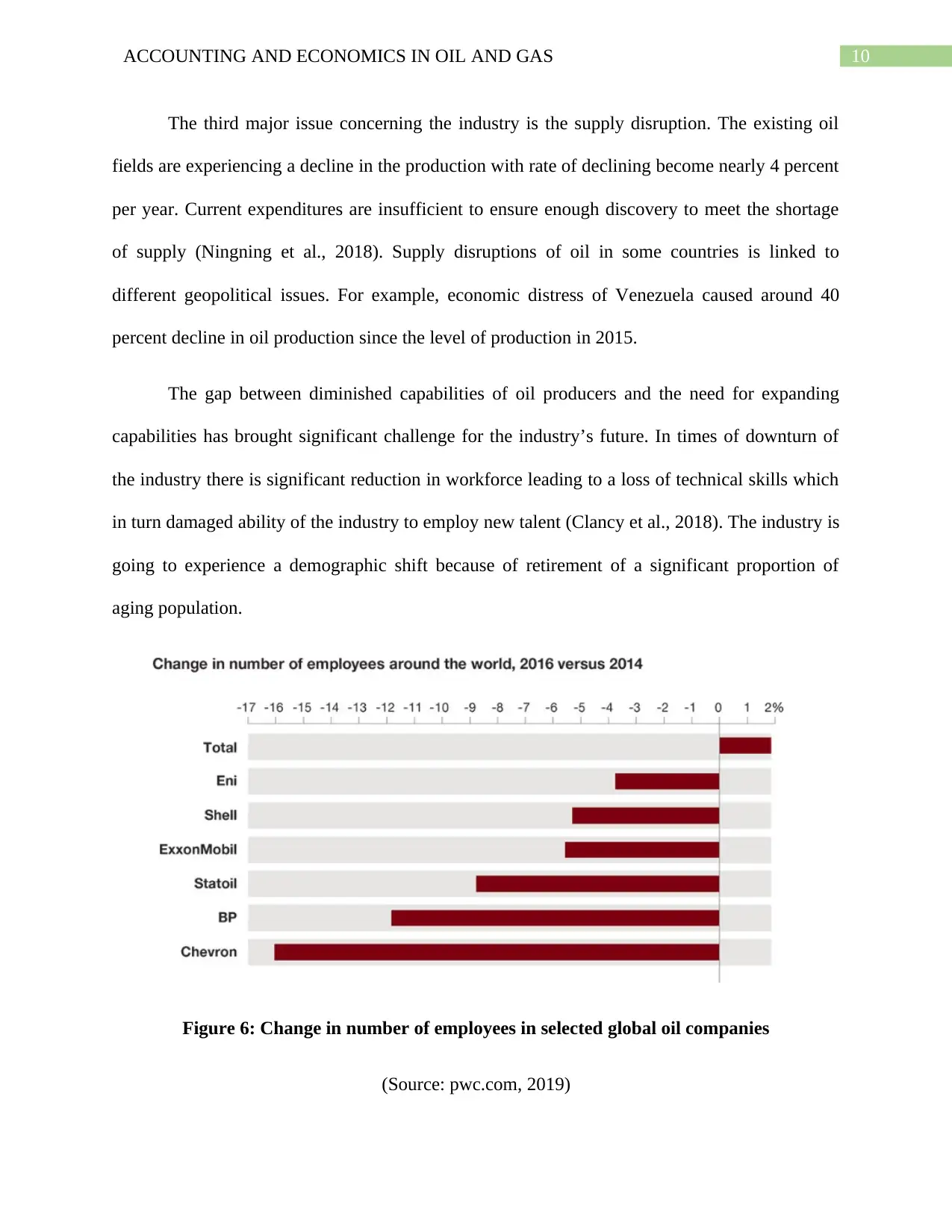
10ACCOUNTING AND ECONOMICS IN OIL AND GAS
The third major issue concerning the industry is the supply disruption. The existing oil
fields are experiencing a decline in the production with rate of declining become nearly 4 percent
per year. Current expenditures are insufficient to ensure enough discovery to meet the shortage
of supply (Ningning et al., 2018). Supply disruptions of oil in some countries is linked to
different geopolitical issues. For example, economic distress of Venezuela caused around 40
percent decline in oil production since the level of production in 2015.
The gap between diminished capabilities of oil producers and the need for expanding
capabilities has brought significant challenge for the industry’s future. In times of downturn of
the industry there is significant reduction in workforce leading to a loss of technical skills which
in turn damaged ability of the industry to employ new talent (Clancy et al., 2018). The industry is
going to experience a demographic shift because of retirement of a significant proportion of
aging population.
Figure 6: Change in number of employees in selected global oil companies
(Source: pwc.com, 2019)
The third major issue concerning the industry is the supply disruption. The existing oil
fields are experiencing a decline in the production with rate of declining become nearly 4 percent
per year. Current expenditures are insufficient to ensure enough discovery to meet the shortage
of supply (Ningning et al., 2018). Supply disruptions of oil in some countries is linked to
different geopolitical issues. For example, economic distress of Venezuela caused around 40
percent decline in oil production since the level of production in 2015.
The gap between diminished capabilities of oil producers and the need for expanding
capabilities has brought significant challenge for the industry’s future. In times of downturn of
the industry there is significant reduction in workforce leading to a loss of technical skills which
in turn damaged ability of the industry to employ new talent (Clancy et al., 2018). The industry is
going to experience a demographic shift because of retirement of a significant proportion of
aging population.
Figure 6: Change in number of employees in selected global oil companies
(Source: pwc.com, 2019)
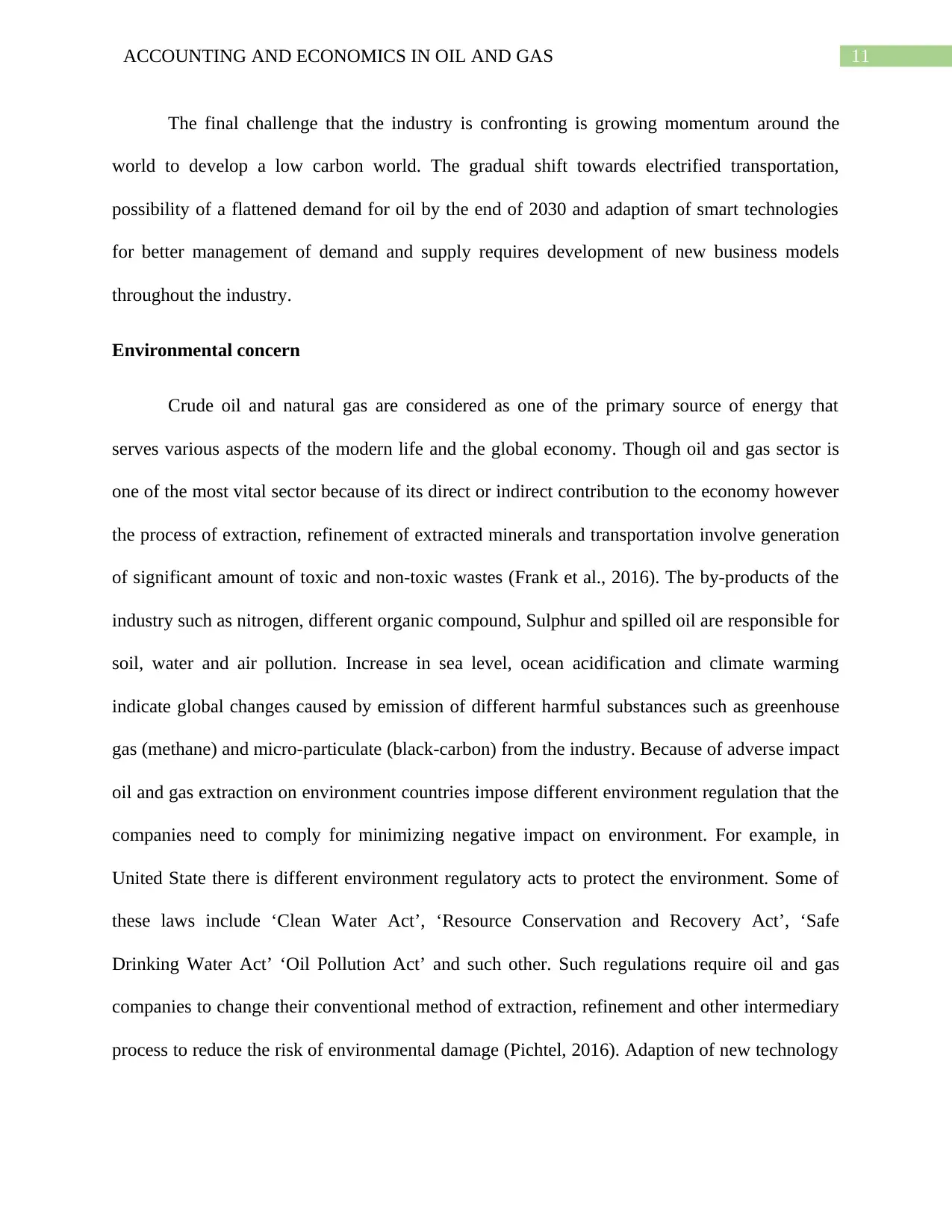
11ACCOUNTING AND ECONOMICS IN OIL AND GAS
The final challenge that the industry is confronting is growing momentum around the
world to develop a low carbon world. The gradual shift towards electrified transportation,
possibility of a flattened demand for oil by the end of 2030 and adaption of smart technologies
for better management of demand and supply requires development of new business models
throughout the industry.
Environmental concern
Crude oil and natural gas are considered as one of the primary source of energy that
serves various aspects of the modern life and the global economy. Though oil and gas sector is
one of the most vital sector because of its direct or indirect contribution to the economy however
the process of extraction, refinement of extracted minerals and transportation involve generation
of significant amount of toxic and non-toxic wastes (Frank et al., 2016). The by-products of the
industry such as nitrogen, different organic compound, Sulphur and spilled oil are responsible for
soil, water and air pollution. Increase in sea level, ocean acidification and climate warming
indicate global changes caused by emission of different harmful substances such as greenhouse
gas (methane) and micro-particulate (black-carbon) from the industry. Because of adverse impact
oil and gas extraction on environment countries impose different environment regulation that the
companies need to comply for minimizing negative impact on environment. For example, in
United State there is different environment regulatory acts to protect the environment. Some of
these laws include ‘Clean Water Act’, ‘Resource Conservation and Recovery Act’, ‘Safe
Drinking Water Act’ ‘Oil Pollution Act’ and such other. Such regulations require oil and gas
companies to change their conventional method of extraction, refinement and other intermediary
process to reduce the risk of environmental damage (Pichtel, 2016). Adaption of new technology
The final challenge that the industry is confronting is growing momentum around the
world to develop a low carbon world. The gradual shift towards electrified transportation,
possibility of a flattened demand for oil by the end of 2030 and adaption of smart technologies
for better management of demand and supply requires development of new business models
throughout the industry.
Environmental concern
Crude oil and natural gas are considered as one of the primary source of energy that
serves various aspects of the modern life and the global economy. Though oil and gas sector is
one of the most vital sector because of its direct or indirect contribution to the economy however
the process of extraction, refinement of extracted minerals and transportation involve generation
of significant amount of toxic and non-toxic wastes (Frank et al., 2016). The by-products of the
industry such as nitrogen, different organic compound, Sulphur and spilled oil are responsible for
soil, water and air pollution. Increase in sea level, ocean acidification and climate warming
indicate global changes caused by emission of different harmful substances such as greenhouse
gas (methane) and micro-particulate (black-carbon) from the industry. Because of adverse impact
oil and gas extraction on environment countries impose different environment regulation that the
companies need to comply for minimizing negative impact on environment. For example, in
United State there is different environment regulatory acts to protect the environment. Some of
these laws include ‘Clean Water Act’, ‘Resource Conservation and Recovery Act’, ‘Safe
Drinking Water Act’ ‘Oil Pollution Act’ and such other. Such regulations require oil and gas
companies to change their conventional method of extraction, refinement and other intermediary
process to reduce the risk of environmental damage (Pichtel, 2016). Adaption of new technology
⊘ This is a preview!⊘
Do you want full access?
Subscribe today to unlock all pages.

Trusted by 1+ million students worldwide
1 out of 20
Related Documents
Your All-in-One AI-Powered Toolkit for Academic Success.
+13062052269
info@desklib.com
Available 24*7 on WhatsApp / Email
![[object Object]](/_next/static/media/star-bottom.7253800d.svg)
Unlock your academic potential
Copyright © 2020–2026 A2Z Services. All Rights Reserved. Developed and managed by ZUCOL.





